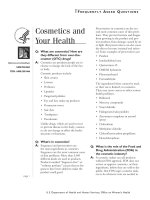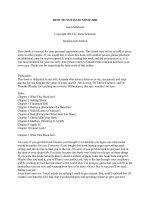Retrain Your Brain, Reshape Your Body pot
Bạn đang xem bản rút gọn của tài liệu. Xem và tải ngay bản đầy đủ của tài liệu tại đây (3.49 MB, 272 trang )
RetrainYourBrain,
ReshapeYourBody
This page intentionally left blank
RetrainYourBrain,
ReshapeYourBody
THEBREAKTHROUGH
BRAIN-CHANGINGWEIGHT-LOSSPLAN
GEORGIA D. ANDRIANOPOULOS, PH.D.
New York Chicago San Francisco Lisbon London Madrid Mexico City
Milan New Delhi San Juan Seoul Singapore Sydney Toronto
Copyright © 2008 by Georgia D. Andrianopoulos. All rights reserved. Manufactured in the United
States of America. Except as permitted under the United States Copyright Act of 1976, no part of this
publication may be reproduced or distributed in any form or by any means, or stored in a database or
retrieval system, without the prior written permission of the publisher.
0-07-159507-4
The material in this eBook also appears in the print version of this title: 0-07-149285-2.
All trademarks are trademarks of their respective owners. Rather than put a trademark symbol after
every occurrence of a trademarked name, we use names in an editorial fashion only, and to the bene-
fit of the trademark owner, with no intention of infringement of the trademark. Where such designa-
tions appear in this book, they have been printed with initial caps.
McGraw-Hill eBooks are available at special quantity discounts to use as premiums and sales promo-
tions, or for use in corporate training programs. For more information, please contact George Hoare,
Special Sales, at or (212) 904-4069.
TERMS OF USE
This is a copyrighted work and The McGraw-Hill Companies, Inc. (“McGraw-Hill”) and its licensors
reserve all rights in and to the work. Use of this work is subject to these terms. Except as permitted
under the Copyright Act of 1976 and the right to store and retrieve one copy of the work, you may not
decompile, disassemble, reverse engineer, reproduce, modify, create derivative works based upon,
transmit, distribute, disseminate, sell, publish or sublicense the work or any part of it without McGraw-
Hill’s prior consent. You may use the work for your own noncommercial and personal use; any other
use of the work is strictly prohibited. Your right to use the work may be terminated if you fail to com-
ply with these terms.
THE WORK IS PROVIDED “AS IS.” McGRAW-HILL AND ITS LICENSORS MAKE NO GUAR-
ANTEES OR WARRANTIES AS TO THE ACCURACY, ADEQUACY OR COMPLETENESS OF
OR RESULTS TO BE OBTAINED FROM USING THE WORK, INCLUDING ANY INFORMA-
TION THAT CAN BE ACCESSED THROUGH THE WORK VIA HYPERLINK OR OTHERWISE,
AND EXPRESSLY DISCLAIM ANY WARRANTY, EXPRESS OR IMPLIED, INCLUDING BUT
NOT LIMITED TO IMPLIED WARRANTIES OF MERCHANTABILITY OR FITNESS FOR A
PARTICULAR PURPOSE. McGraw-Hill and its licensors do not warrant or guarantee that the
functions contained in the work will meet your requirements or that its operation will be
uninterrupted or error free. Neither McGraw-Hill nor its licensors shall be liable to you or anyone else
for any inaccuracy, error or omission, regardless of cause, in the work or for any damages resulting
therefrom. McGraw-Hill has no responsibility for the content of any information accessed through the
work. Under no circumstances shall McGraw-Hill and/or its licensors be liable for any indirect, inci-
dental, special, punitive, consequential or similar damages that result from the use of or inability to use
the work, even if any of them has been advised of the possibility of such damages. This limitation of
liability shall apply to any claim or cause whatsoever whether such claim or cause arises in contract,
tort or otherwise.
DOI: 10.1036/0071492852
For Andria and David
In memory of my father, Demetrios G. Andrianopoulos.
He envisioned and inspired a life of knowledge.
This page intentionally left blank
vii
Contents
Acknowledgments ix
Introduction xi
PART 1
Discover
1 Your Brain: An Introduction 3
2 The First Step: Discover Your
Eating Brain and Find Your Wobble 21
PART 2
Reframe
3 The Second Step:
Reframing the Way You Think 55
4 What the Eating Brain Has Done,
It Can Undo: The Ever-Changing Brain 77
PART 3
Retrain
5 The Third Step: Retraining
with Global Mind Fitness Tools 103
6 Retraining Revisited:
Eating Neuroregulation Tools 167
7 The BrainMed Diet:
Eating
the Mediterranean Way 201
For more information about this title, click here
Conclusion 217
Resources 221
References 223
Index 237
viii
•
Contents
ix
Acknowledgments
T
his work would not have been possible without the support
of the people who contributed raw material and the editors
that helped sculpt and shape that material into this book.
First, I want to acknowledge the people who helped seed
the ideas behind this book. My deepest gratitude and affection
for my advisor and teacher the late Robert C. Wilcott, Ph.D.,
for opening up the world of neuroscience for me. I am grateful
to Richard L. Nelson M.D. for the decades of tireless support,
guidance and for his help reviewing all of my work, includ-
ing this book. Many thanks to Dan MacDonnell R.N., M.S.,
for his dedication to the practice of neurofeedback and for his
thoughtful feedback that sparked many of the ideas incorpo-
rated in to the programs in this book. By far the most enriching
contributors to the material have been the people whom I have
treated through the years. I would like to thank them for their
willingness to share their thoughts and feelings with me. They
continue to inspire and motivate me to do better.
Now for the artists, the sculptors of the raw material: I am
deeply grateful to my daughter, Andria E. Cress, for using her
scientifi c and literary skills along with her gentle, razor-sharp
mind to help edit this book. I owe many thanks to Johanna Bow-
man at McGraw-Hill for being my unwavering, most empathic
Copyright © 2008 by Georgia D. Andrianopoulos. Click here for terms of use.
“rock” from the very beginning of this project. This book would
not have been possible without her diligence, optimism, and
dedication. I am also grateful to Dr. Gerald J. Mozdzierz for his
gentle guidance and encouragement though this process. Also,
many thanks to Susanna Margolis for helping me organize the
material.
I want to honor my mother Vassiliki and thank my family,
especially my son for the many hours of waiting for me to stop
writing. Finally, I want to thank my four sisters, Helen, Kon-
stantina, Anastasia, and Phaedra for carrying the legacy of our
parents.
x
•
Acknowledgments
xi
Introduction
I
f you are going to lose excess weight permanently, if you are
going to reshape your body, it’s probably best that you forget
what you know about overeating and weight gain. I wrote this
book to provide a beginning to a new way forward, away from
what I perceive as outdated, irrational, ineffective, harmful, and
even dehumanizing approaches to weight management.
Don’t get me wrong. Weight loss is still a matter of eating less
and exercising more, of taking in fewer calories and burning
them up more effectively. And the hundreds, if not thousands,
of diets out there in all their infi nite variety are, for the most
part, sound and healthy ways to do just that.
But you can go on diet after diet after diet, as perhaps you
have, and chances are you’ll continue to gain back any weight
you lose. The reason? Dieting attacks only the symptoms of
your weight problem, not the cause. To get off the diet weight-
loss/weight-regain roller coaster, you’ll have to retrain the one
organ in your body that really manages eating behavior and
weight—your brain.
This book tells you how.
Copyright © 2008 by Georgia D. Andrianopoulos. Click here for terms of use.
xii
•
Introduction
It Really Is All in Your Head
Of course, the fact that the brain regulates our eating is not
exactly breaking news. Neurophysiologists have known for
more than half a century that the brain controls appetite, and
research since then has made it clear that weight gain is a symp-
tom of trouble with the brain’s energy regulation systems.
I vividly remember a photograph from my physiology text-
book back in my sophomore year of college. Sitting atop a set
of laboratory scales were two white, furry animals, one on each
tray. I quickly identifi ed the smaller of the two, weighing 520
grams, as a white lab rat. But I wasn’t sure about the one on the
other scale. It was huge and round, tipping the scale at about
1,080 grams. A strange-looking white cat? Some newly discov-
ered species I hadn’t heard about?
The caption told the tale of the two rats: this was a photo
of one “normal” and one “hyperphagic” rat. My Greek roots
helped me understand the meaning of the word hyperphagic:
hyper ϭ “too much,” phagic ϭ “food/eating.” But being Greek
didn’t help me understand the mystery—what was causing this
rat to eat to the point of weighing more than double the aver-
age rat weight? It turns out that the hyperphagic animal ate too
much because six months earlier, the area inside its brain that
signals satiety (feeling full) had been damaged. Without it, the
brain’s feeding center had no way of switching off the eating
urge, so the rat kept eating pretty much around the clock.
You too have an on/off feeding switch in your brain. It is
located in a structure known as the hypothalamus, deep inside
the middle of the brain. Ideally, the mechanisms that turn it on
and off are balanced between hunger and satiety, allowing you
to eat when you’re hungry and stop eating when you’re full. But
I certainly don’t have to tell you that it doesn’t always work that
way! Just about everyone eats for reasons that have nothing to
do with hunger. We eat because we are looking for the pleasure
Introduction
•
xiii
that comes from the taste of certain foods. We eat when we are
frustrated or bored. We eat for comfort, for escape from fatigue,
or when we want to postpone something unpleasant.
In fact, science tells us that thousands of triggers having noth-
ing to do with the basic physiological need for food can turn
on the human eating brain—the whole network of mechanisms
that regulate what we eat, when we eat, and the way we eat.
Once the brain is triggered by all those eating mechanisms,
it is virtually unstoppable. So obviously, if you try to counter all
this brain power that compells you toward eating by putting your-
self on a rigorous regimen of calorie counting or food depriva-
tion, you’re pretty much doomed to failure. You may lose some
weight—in fact, you probably will—but all you will have done
is treat the symptom, not the underlying cause. Unless you do
something about the root causes of your desire to overeat, your
weight problem will reappear and will probably become a lifelong,
nagging pain. We certainly wouldn’t think of treating symptoms
without looking for root causes in other medical conditions. Think
about it: If your child ran a fever for weeks on end, would you be
satisfi ed to continue giving him aspirin and cool baths to lower his
temperature? Or would you demand that the doctor do everything
possible to determine the cause so you could take action to end
your child’s discomfort once and for all? Of course, you would do
the latter. And that is precisely what you are now going to do about
your excess weight—resolve the cause in your brain, not just the
symptoms measured on your bathroom scale each morning.
But how?
A Wobble in the Brain
As we’ve just seen, and as you’ll read about in greater detail
in the following pages, being overweight is a symptom of a
xiv
•
Introduction
lazy brain or a disruption in the brain’s ability to regulate key
functions and systems including systems that regulate eating
and weight. The scientifi c term is global dysregulation, but the
result is the same: lazy brain! Think of it as a little like forget-
ting to set your watch forward for daylight saving time or back
for standard time. Your watch will still work, but your life will
be out of sync. In the case of weight management, your brain
is managing your weight all right, but it’s always a step ahead or
behind. Your brain tries to regulate your eating—maintaining
balance in all systems is, after all, its main mission—but it falls
short. Think of what happens when you arrive late for your fi rst
appointment at work on one of your busiest days, when the sec-
ond appointment is contingent on the outcome of the fi rst and
so on. The whole “pyramid” crumbles, and you play catch-up
all day. You still manage to carry out most, if not all of the jobs
on your list that day, but it’s certainly not a comfortable process.
Being out of sync makes a huge demand on your energy and
can leave you feeling exhausted and frustrated. On top of that,
chances are you didn’t do as good a job as you could have if you
had started your day on time.
This scenario is akin to what happens inside your brain
when, for whatever reason, it loses its ability to run smoothly or
balance its numerous functions. When the brain is in a state
of dysregulation, it behaves similar to you when you’re run-
ning late: it plays catch-up by robbing Peter to pay Paul. Didn’t
have enough time to sleep? Have something sweet. You duti-
fully obey the brain’s command and fi nd time to stop for a
donut, even when you are running an hour behind schedule.
When the brain is not running smoothly, or is wobbling, its
performance—how well it does its various jobs—also suffers.
The brain loses the ability to recognize and maintain a healthy
weight. Wobble in the brain consumes resources that might
otherwise be used to regulate weight. The parallel is akin to
Introduction
•
xv
being in the midst of a work-related crisis; issues such as the
state of your hair or outfi t lose priority! You may also fi nd that
you are sleeping poorly, suffer from poor memory, have intense
cravings for sweets and carbohydrates, and are often on edge or
emotionally raw.
Wobbling also means that the brain’s “braking” system, the
system that allows you to consider the consequences before eat-
ing a whole cake, malfunctions. The result of a lazy brain! So,
you proceed to demolish a bag of chips in a matter of minutes,
while your better judgment watches in horror.
There’s no cause for alarm; this does not mean there is
anything “wrong” with your brain or with you. It’s just that
something has thrown your brain slightly off balance (made
it wobble). Eating a cookie can be the brain’s way of attempt-
ing to regain balance, to run more smoothly and get rid of the
wobbling. But, unfortunately, the “balance” it goes back to is
also out of kilter.
So how did this dysregulation occur? There is much specula-
tion, but it seems safe to say that along with heredity, your life
experiences and personal lifestyle choices had a hand in causing
it. Not deliberately and not consciously, but you did it neverthe-
less. Which means, of course, that you can undo it as well.
How did you cause it? It started back in childhood. (Actually,
it may have started in the womb. Your brain could have been
programmed to overeat by your mother’s nutritional state before
you were born.) Her weight and eating habits before and during
pregnancy could have altered your food preferences and body
weight; increasing your susceptibility to weight gain. However,
your eating patterns—how much you eat, the types of foods
you desire—continued to be constructed during childhood
and throughout your lifetime. The foods you eat today, along
with your emotional experiences and physical well-being deter-
mine what and how much food you crave tomorrow! Do you
xvi
•
Introduction
ever remember falling and scraping your knee as a kid? Prob-
ably your mother or father kissed the wound, then very likely
marched you into the kitchen for a cookie, some ice cream, or
a piece of cake, which you were assured would make your hurt
feel better.
You believed it. Your brain believed it and made sure to
remember that trick: pain eases when you eat something sweet.
So, in all innocence, a bad eating habit was born—namely,
curing pain with food. And not just any food, but heavily sweet-
ened, high-calorie food—the kind that puts on weight in all
the wrong places in all the wrong ways. By the way, all sorts of
emotional pain, not just scraped knees, can be relieved with
sweets.
That’s the bad news. The good news is that the brain is a
brilliant organ, one that is always learning and always rewiring
itself. So what you trained it to do with years of bad or inappro-
priate eating habits, you can undo by retraining it in another
direction.
That’s exactly what this book will teach you to do. It will help
you retrain your brain to get rid of the wobble—or dysregula-
tion—and prevent you from running toward food as a solution
to problems. It will help establish an equilibrium that can make
it easier to put on the brakes to avoid consistent overeating. A
balanced brain makes you feel best when you are eating health-
fully. It sounds simple, and it is.
Follow the program in this book, and you’ll learn to rewire
your brain. You’ll teach it to become better balanced and learn
new responses to the wobble, so the next time you get the
equivalent of that scraped knee, you’ll fi nd comfort and brain
balance in something other than a high-calorie sweet treat.
I said it was simple, but I didn’t say it was easy. You’re up
against some stiff challenges—not just the eating patterns you’ve
Introduction
•
xvii
had for years, but also a food industry and a cultural environ-
ment that encourage excessive and inappropriate eating, then
hold up extreme skinniness as the ideal of beauty.
But once you understand that the source of your extra weight
is a wobble in your brain and that you can straighten that wob-
ble out through conscious effort, you’re halfway to your goal
of a healthy weight—and to a brain that delivers peak perfor-
mance in every aspect of your life.
A Fit Brain in a Thin Body—Through
Neuroscience
I make this promise of change based on years of research and
brain fi tness training that have changed the lives of hundreds
of patients. My fi eld is physiologic psychology with a focus on
eating disorders. I began my work in eating disorders at the Uni-
versity of Illinois College of Medicine, department of surgery,
in the mid-1980s; there, I concentrated on studying the role
of stress, physical activity, and various diets in gastrointestinal
disorders, including cancer. I brought the results of those stud-
ies and research to my teaching work in the medical school’s
departments of surgery and psychiatry and to my job as director
of the eating disorders clinic at the University of Illinois Medi-
cal Center at Chicago.
Over the years, my own research and the exciting new fi nd-
ings of neuroscience—that is, the study of the brain, spinal
cord, and nervous system—became the basis for practical solu-
tions to fi ght obesity, overweight, and other conditions caused
by inappropriate eating.
I was especially encouraged by recent research fi ndings
that show we are not doomed to live with the brains we inher-
xviii
•
Introduction
ited or grew up with. Our brains show neuroplasticity; they
are adaptable and can be reprogrammed throughout our life-
time by our daily experiences. They are not “fi xed, ended and
immutable” as the neuroanatomist Ramón Cajal said in 1913.
In 1999, I put it all together in Optimal Performance Train-
ing (OPT), the program you’ll learn about in this book, and
founded Brain Fitness, Inc., a center for the practical applica-
tion of brain-based tools to achieve weight loss. At our clinics
in and around Chicago, the brain is the target organ—front
and center—for individuals seeking help with eating and
weight regulation. We fi nd that the job of weight manage-
ment is much easier when the brain cooperates and runs more
smoothly.
I’ve also put this research to work in an eating plan that com-
bines the best of a Mediterranean-style diet (I told you I was
Greek!) with the latest neuroscientifi c fi ndings on foods that
promote brain fi tness. The BrainMed Diet, as I call it, is also
included in this book.
Of course, advances in neuroscience have already given
birth to “neuro” solutions to address all sorts of struggles and
challenges: depression, attentiveness, and focus, even jealousy.
George H. W. Bush’s declaration of the nineties as the “decade
of the brain” brought this part of our anatomy to the forefront.
There are books and lectures and symposia on neurocomput-
ing, neurorehabilitation, neurolinguistics, even neuroacupun-
ture—not to mention general treatises on how to have a better
brain in order to have a better life. Agencies have even entered
the fi eld of neuromarketing—using the brain’s nature to peddle
a specifi c brand of gym shoe or chocolate cookie.
But in the arena of eating and weight management, it’s the
food industry that has made the most dramatic use of neurosci-
entifi c fi ndings, using what science teaches us about the brain
to get to your wallet by way of your stomach.
Introduction
•
xix
It isn’t just that food manufacturers want you to eat as much
as possible; they also want you to eat as often as possible. And
they routinely use scientifi c data to manipulate your brain to
get you to do both. They do it in their marketing strategies, and
they do it with additives that can actually affect your appetite
and your eating habits.
Some of the marketing is pretty obvious. If you watch televi-
sion, you are bombarded by appealing food commercials aimed
at increasing activity in the irrational, emotional, and uncon-
scious part of the brain known as the limbic system. That’s
where the food marketers get you. They don’t want you to act
rationally at all; they want you simply to react—unconsciously
and without thought. So you may be utterly unaware that you’re
even paying attention to the commercial, yet subliminally that
carefully composed TV image of a brownie sundae—or a very
attractive person enjoying a brownie sundae—goes right for
the emotional part of your brain. Suddenly, almost like one of
Pavlov’s dogs, you’re heading for the fridge or the pantry—or
hopping in the car—to do whatever you have to do to obtain
that delicious taste.
Some of the marketing strategies are covert. Next time you’re
in your local supermarket, take a look at the products on the
“corners” of the aisles. That’s where store managers tend to
place the high-calorie snack foods with low nutritional value
and high profi t margins: chips, cookies, cakes, and the like. The
reason? Study after study has demonstrated conclusively that
nothing sells as well as corner foods—especially those placed
at eye level.
But clever marketing strategies based on years of psychologi-
cal research are only part of it. Food additives are the other side
of the coin, and the food industry is adept at adding compo-
nents to their food products that manipulate us to crave certain
foods and to eat because of cravings when we are not hungry.
xx
•
Introduction
It’s not that hard to do. As you’ll learn in this book, the
emerging fi eld of nutrigenomics shows that our brains and even
our DNA are actually reconfi gured by the foods we eat. Food
can turn genes on or off and infl uence not only your weight
and the foods you crave, but health and disease. We’ve long
known, for example, that some people who are exposed to a
diet that’s high in fats, sugar, and calories early in life tend
to become permanently vulnerable to being overweight. And
we’ve learned at least in part why that is so: simply put, those
kinds of foods actually stimulate the growth of pathways that
connect areas of the brain where addictions are born. Some
food ingredients may actually rewire the brain’s pathways. This
means that your desire for these foods originates in the same
brain areas as the desire for addictive substances like heroin or
alcohol. Along with the rewiring of the pathways comes behav-
ioral changes—among them, an avoidance of physical activity
and an intense desire to taste these comfort foods (“I have to
have it now!”).
So the food industry has put its laboratories to work to devise
manufactured additives and combine nutrients in ways that can
have similar effects, producing cravings for specifi c tastes and
specifi c foods. What’s more, they have tried to make these crav-
ings intense beyond anything ever before experienced by the
brain, so they are unlikely to be countered by willpower, no
matter how formidable. The labs have succeeded admirably,
producing foods containing substances that actually manipu-
late our future eating behavior.
Science is neutral; it’s how it is used—and who does the
using—that determines its impact. There’s nothing illegal about
food manufacturers paying psychologists to study human con-
sumer behavior, and it’s as fair as anything else in love or war,
but this use of science by the food industry has been decidedly
one-sided. Until now.
Introduction
•
xxi
The Optimal Performance Training Program
Optimal Performance Training (OPT) is an exercise program
for the brain that concentrates on weight loss, and it works the
same way any exercise program works. Think of the skier pre-
paring in autumn for the fi rst snowfall. She’ll start with general
conditioning to get in good overall shape, then focus on exer-
cises that strengthen her legs and improve her balance and sta-
bility. Similarly, OPT exercises are designed to boost the brain’s
overall performance as well as target specifi c “muscles” or areas
that are especially important to eating and weight regulation.
You’ll do this type of training in the three steps of the OPT
program:
1. Discover. You’ll identify and analyze your own
personal wobble and see how it affects your eating.
2. Reframe. By exploring where your wobble comes
from, you’ll begin to look at eating in a whole new way.
This freshly perceived framework will enable you to
focus on what needs changing.
3. Retrain. You’ll do the “workouts” that will bring
your brain to optimal performance so that it seeks
equilibrium in healthful living.
The same science the food industry has used to turn your
brain into an instrument of weight gain is used in OPT to turn
your brain into an instrument of weight loss. You might say
we’re fi ghting the enemy with the enemy’s own tools, using the
same database of neuroscientifi c fi ndings to help curb overeat-
ing and ensure a healthy and manageable weight.
As perhaps the only weight-management program that
focuses on brain retraining and rebalancing as the fi rst step
to weight loss, the program has seen startling success. OPT
xxii
•
Introduction
graduates don’t just lose weight; they gain brain fi tness that
affects every aspect of their lives, opening those lives to all new
possibilities.
That is the kind of success I want to bring to a wider audi-
ence. I know that even a few weeks of training can minimize
your brain’s wobble and set you on the path to a new level of
brain fi tness and weight loss. Your health and your life will
be the winners. After all, no one knows better than you that
entanglement with eating is like being chained to food. But
the brain that is the fi rst cause of your weight gain is also the
thing that can free you from the oppressive burden of being
overweight.
Your brain is a remarkable instrument, and it is yours to com-
mand. Are you ready to retrain and rewire it away from inap-
propriate, unhealthy eating—and other wobbles—toward peak
performance and permanent weight loss? Let’s begin by getting
to know this extraordinary weight-loss tool you possess.
Discover
PART 1
Copyright © 2008 by Georgia D. Andrianopoulos. Click here for terms of use.
This page intentionally left blank









